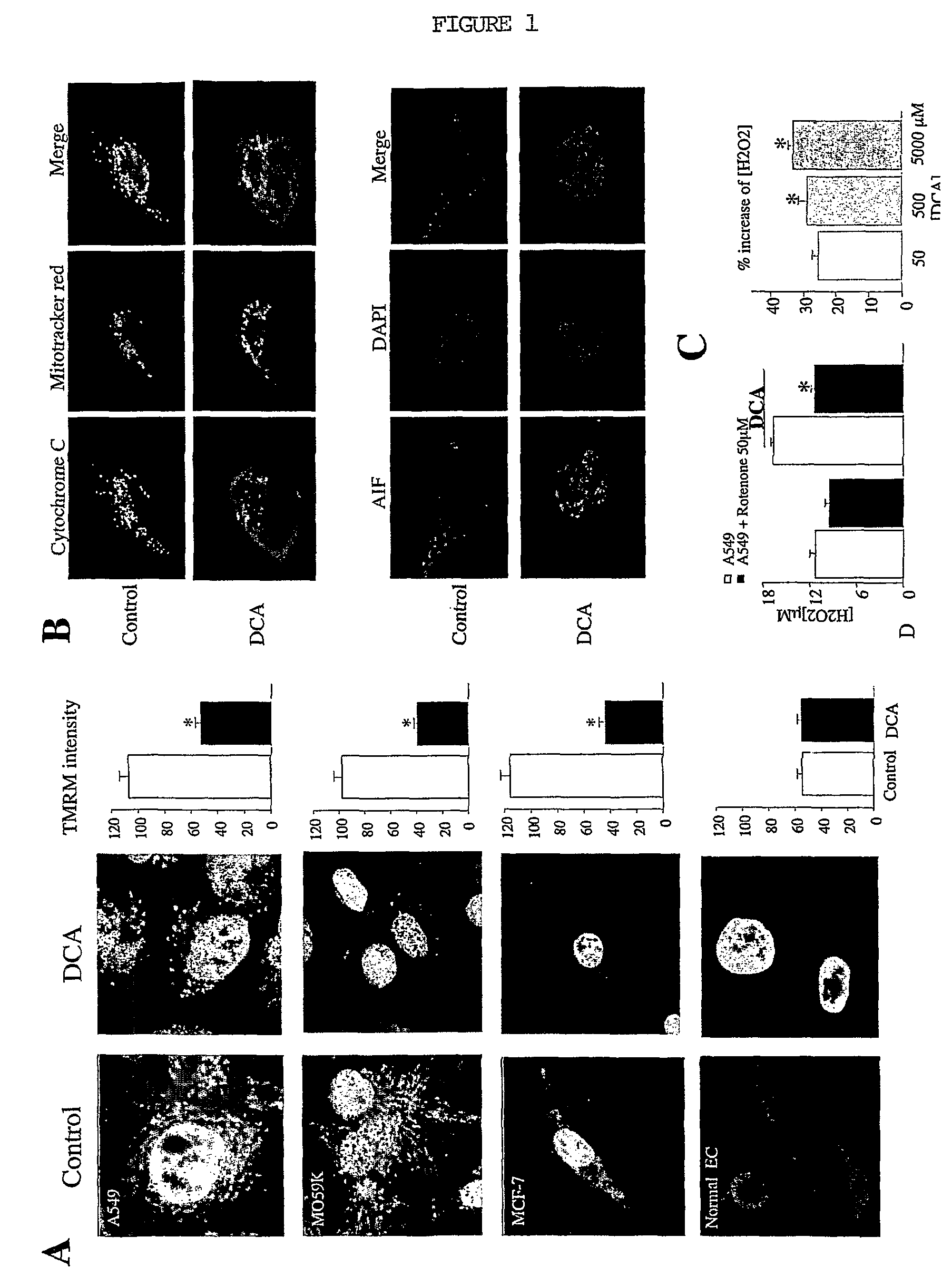Method of treating cancer using dichloroacetate
a technology of dichloroacetate and cancer, applied in the field of dichloroacetate, can solve the problems of apoptosis but high toxicity
- Summary
- Abstract
- Description
- Claims
- Application Information
AI Technical Summary
Benefits of technology
Problems solved by technology
Method used
Image
Examples
example 1
DCA Depolarizes Mitochondria, Releases Cytochrome-c and AIF from the Mitochondria and Enhances H2O2 Production (FIG. 1)
A: 48H of DCA (500 μM) significantly depolarized the mitochondria in A549, MO59K, MCF-7 cancer cells, but had no effect on normal epithelial cells (EC).
B: In the upper panel, cytochrome-c in green is co-localized with the mitotracker red staining in control, whereas after 48H DCA cytochrome-c leaked out the mitochondria and is localized into the cytosol.
C: In control (upper panel) AIF in red is not localized in nucleus, whereas after 48H DCA AIF is mainly localized into the nucleus.
D: DCA increases H2O2 production in a rotenone and dose-dependent manner.
example 2
DCA Increases K+ Current and Repolarizes Cancer Cells without Affecting Normal Cells (FIG. 2)
[0067]A: 48H DCA (500 μM) increases K+ current density in all cancer cells lines (A549, MO59K and MCF-7) but does not affect normal cells such as the normal epithelial cells. On the right, original traces representing the K+ current in both control (untreated cells) and DCA treated cells. Increase in K+ current density was mainly due to an increase in Kv current, as shown by the 4-AP-sensitive current in the legend. Increased K+ current density results in a significant decrease in membrane capacitance, (which suggests a decrease in cell volume) and repolarization of the resting membrane potential.
B: The mechanism by which DCA increases K+ current was assessed by cancer cells acutely exposed to DCA (10 min, 500 μM). The effects of DCA on K+ current were blocked by 4-AP and blocked by both catalase and rotenone (50 μM). TTFA, a specific blocker of complex II did not prevent the effects of DCA....
example 3
DCA Increases Kv1.5 Via the Ca++ / Calcineurin-Dependent Transcription Factor NFAT (FIG. 3)
[0068]A: Free cytosolic calcium concentration was measured using fluo-3. Control cells had more calcium than both DCA and H2O2 treated cells. Acute DCA decreased the calcium concentration through a 4-AP and rotenone sensitive pathway confirming the electrophysiology data.
B: Confocal imaging of A549 cells showed that NFAT (green) is activated as it is mainly localized in the nucleus of most of the untreated cells. Interestingly, these cells had a very low level of Kv1.5 expression (red). Both DCA and H2O2 blocked the activation of NFAT as shown by its localization out of the nucleus in the cytoplasm, and had increased Kv1.5 expression.
PUM
| Property | Measurement | Unit |
|---|---|---|
| apoptosis resistance | aaaaa | aaaaa |
| resistance | aaaaa | aaaaa |
| energy | aaaaa | aaaaa |
Abstract
Description
Claims
Application Information
 Login to View More
Login to View More - R&D
- Intellectual Property
- Life Sciences
- Materials
- Tech Scout
- Unparalleled Data Quality
- Higher Quality Content
- 60% Fewer Hallucinations
Browse by: Latest US Patents, China's latest patents, Technical Efficacy Thesaurus, Application Domain, Technology Topic, Popular Technical Reports.
© 2025 PatSnap. All rights reserved.Legal|Privacy policy|Modern Slavery Act Transparency Statement|Sitemap|About US| Contact US: help@patsnap.com



